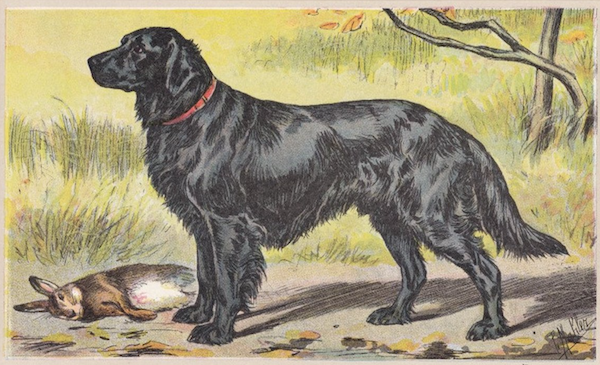
When wording in a breed standard withstands the sands of time, it suggests a well written document with which generations of owners and breeders have been in agreement. The current Flat-Coated Retriever breed standard was revised in 1990, and the words, “power without lumber and raciness without weediness,” appear in it as they did in previous editions of the standard. We were curious if the phrase appeared in the standard as it was written the very first time.
Learning the answer turned out to be a bit of an investigate hunt. We simply could not find what we considered to be old breed standards for the Flat-Coated Retriever, and various articles and books of a historical nature merely hinted at the phrase.
Vero Shaw’s, “The Classic Encyclopedia of the Dog (covering dogs from 1870-1890) mentioned the importance of showing power in a Flat-Coat, while the word, “reedy,” shows up in Charles Eley’s The History of Retrievers published in 1921. Ultimately, it was Brynn White, archivist at the AKC Library & Archives, who brought us some closure. After a thorough search, she found no official published standard for the breed until the first Complete Dog Book published in 1929, even though the breed was recognized in 1915. That said, the 1929 breed standard did contain the clause, “power without lumber and raciness without weediness.”
It is only speculation on our part that the authors of the 1929 standard borrowed from a compilation of material to include the key words of the phrase that has endured for ninety years, and there is no misinterpreting their intent. The authors wanted there to be no mistaking a Flat-Coated Retriever for a Labrador Retriever or a Golden Retriever even though “…the breed must embody the peculiar virtues of half a dozen breeds and possess none of their failings” (Charley Eley).
A Flat-coat should neither be heavy, cobby, showing substance, or overloaded in the front, nor be too short on leg, lanky, or skinny. Legs too long or a setter-like appearance is untypical for a Flat-coat, making it physically less fit for the job it is supposed to provide. In the end, a Flat-Coat is a dog with a strong, athletic constitution built like a person with loose morals: Fast and easy.
As an aside, in the search for an old breed standard, we came across something the Kennel Club in England wrote: “Many of the breed standards date back a long time but are continually reviewed to ensure that they evolve with the breeds that they describe.”
“Evolve with the breed.” Is that a good thing? Could it be a worrisome hint that breeders should shape the standard, rather than breed to the standard?
Getting back to the breed at hand, we conclude that the continued inclusion of the phrase, “power without lumber and raciness without weediness,” has been “good enough” to retain in the breed standard for several generations, and it is perhaps why the breed has exhibited admirable consistency over time.
We offer special thanks to the people who helped us find more information about the Flat-Coated Retriever standard, and old standards, in general: Michelle, Karyn, Chiens, Dawn, Peri, Florence, Ute, Ginger, Linda, Elaine, Bethany, Andy and Karen.
Image: Original Vintage French Dog lithograph from le Chien de Chasse offered by TheLotAntiquePrints is available here.

Did you look in the Book of British Dogs? There is a handy guide to points for judging the breed as well.
Pauline, we’ll look for that book! (any excuse to get another dog book!)